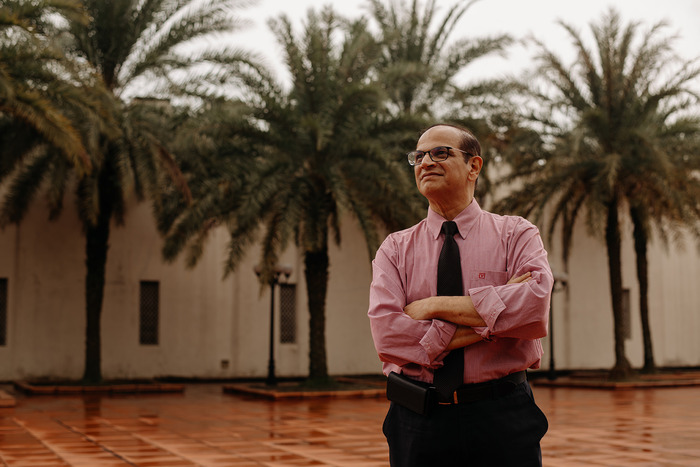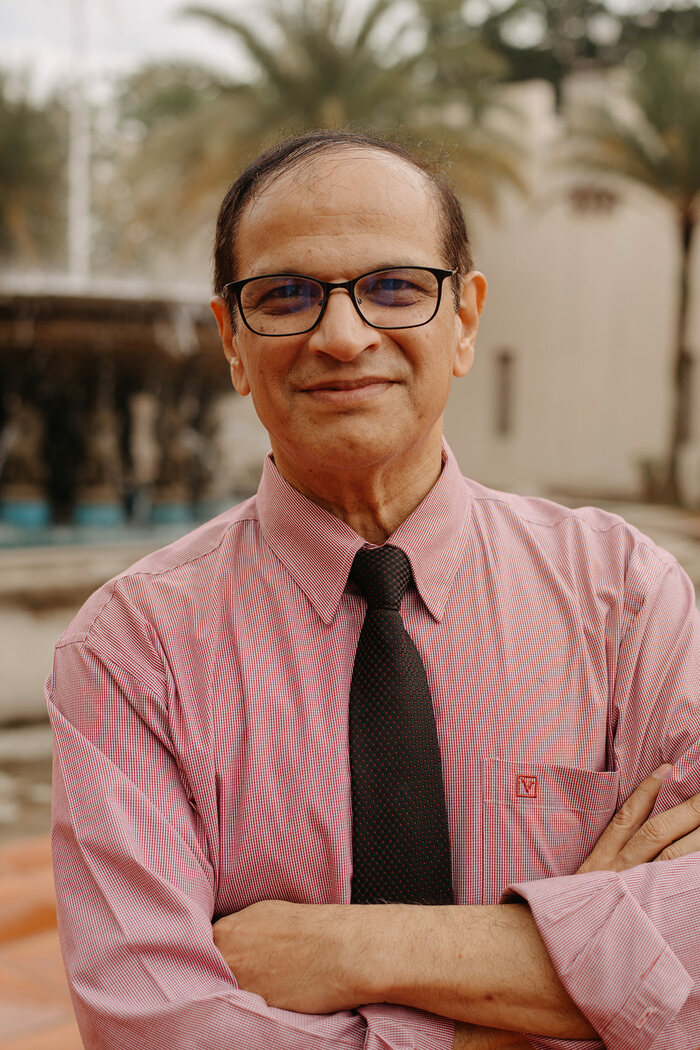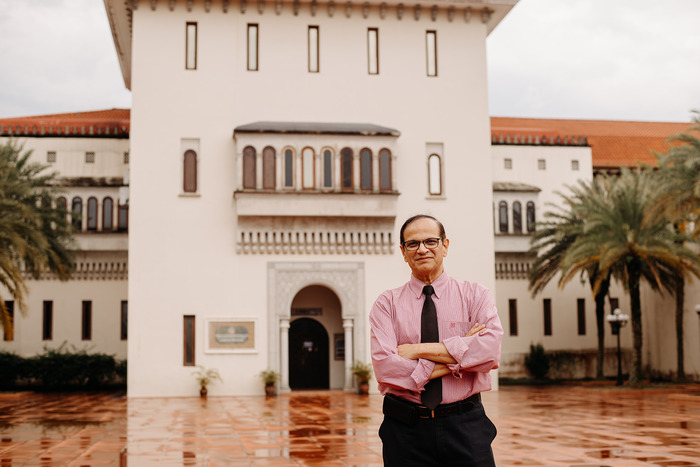
I’m in Kuala Lumpur, the hot and bustling capital of Malaysia, and it is raining heavily. So heavily, in fact, that it feels like you couldn’t be anywhere on earth except this part of the world, hiding in fiercely air-conditioned malls surrounded by the sticky heat of rainforests that stretch for hundreds of miles. And I have to make my way to the International Islamic University Malaysia – if I can find a taxi, that is – to meet a man who is considered to be one of the world’s foremost experts of Islamic-Buddhist relations.
That is, of course, Dr. Imtiyaz Yusuf, a distinguished scholar whose academic pursuits delve into the intricate intersections of religion, culture, and coexistence. With a scholarly fervor fueled by a profound commitment to understanding and fostering harmony among diverse faith traditions, Dr. Yusuf stands as a beacon of intellectual curiosity and interfaith dialogue.
As a faculty member at the International Institute of Islamic Thought and Civilization, Dr. Yusuf brings a wealth of knowledge and experience to the table, serving as a guiding light for students and colleagues alike. His research encompasses a wide array of topics, with a particular focus on the nuanced relationship between Islam and other religious traditions, but especially Buddhism.
In my interview with Dr. Yusuf, the conversation delved into the fascinating parallels and distinctions between Buddhism and Islam. With a keen eye for detail and a deep appreciation for both faiths, Dr. Yusuf explores the shared principles of compassion and ethical conduct that underpin these ancient traditions. Moreover, he sheds light on the potential for peaceful coexistence and mutual respect among adherents of Buddhism and Islam, emphasizing the importance of dialogue and understanding in a world marked by diversity and complexity.
An intriguing aspect of the conversation centered around the notion of the Buddha being mentioned in the Quran, a topic that has sparked considerable debate and scholarly inquiry. Dr. Yusuf offers us valuable insights into the historical context and interpretations surrounding this matter, drawing upon his expertise in Islamic studies to provide a nuanced perspective.
Read on to learn more about Buddhism and Islam from Dr. Yusuf, a self-described Muslim who believes in God and learns from the Buddha, in this enlightening conversation. Enjoy!
Study Buddhism: I imagine, in the minds of many Muslims and Buddhists alike, Islam and Buddhism seem to have little in common. Can you share with us some wisdom to dispel this misconception?
Dr. Imtiyaz Yusuf: The basic values shared by Islam and Buddhism are about promoting good and forbidding doing evil. The Quran teaches Muslims that evil comes from human beings, it does not come from God. Evil is done by human beings, and that leads to the suffering of human beings. This is similar to Buddhism.
Let me give you one example from the life of the Prophet Muhammad. One day, he was sitting with his grandchildren, and he was kissing them when a passerby said, "Why do you kiss your grandchildren? I have ten children and I've never kissed any of them." Muhammad replied, "If you don't give love, you don't receive love." That is how Muhammad taught us to love each other.

You may have noticed that Muslims come in many different colors and races. We believe in the equality of human beings. The equality of human beings means we don't discriminate on the basis of skin color, which is a very important teaching in Islam. The Quran says religious diversity and religious differences are natural, but we should compete with each other to do good. He taught to love people of other religions. One day, Muhammad was sitting by the road and a funeral procession was passing by, and he stood up in respect for the funeral. One of his companions told him, "But don't you know that it's the funeral of a Jewish person?" And Muhammad said, "Was he not a human being?" So, the teaching we have from Muhammad is that that we should love humanity, and that all human beings are equal, irrespective of race.
And we should learn to love Buddhists too. There is fear and ignorance on both sides, yet ignorance is criticized both by the Buddha and Muhammad, as ignorance leads to evil, and evil leads to violence.
On a more philosophical level, you wrote a paper on the Islamic concept of ummatan wasaṭan (the middle people) and the Buddhist concept of majjhima-patipada (the middle way). How do these concepts compare to each other?
The term "middle people" is used in the Quran, it's called "ummatan wasaṭan" and it basically tells Muslims to avoid extremism in all areas of life and practice. And Muslims should be middle-roaders, which means they should not disturb the balance between the mundane and religious or spiritual affairs of life. They should be compassionate, they should be tolerant, they should not be extreme. This is what the Quran means when it calls upon Muslims to be the middle people.
It's very, very similar to the Buddha's eightfold path, which is also a middle path. Muhammad himself asks Muslims to be middle people and avoid extremes, just like the Buddha says that Buddhists should avoid extremes in their life and practice.
By the end of the 12th century, Buddhism had largely disappeared from the Indian subcontinent with the exception of the mountainous Himalayan regions. Many scholars have attributed this decline of Buddhism, which coincided with the spread of Islam, to the Islamic invasions, one of which destroyed Nalanda, the renowned center of Buddhist learning. How accurate is this?
I find it ridiculous when someone says that when you destroy a building, you destroy a religion. Of course that did not happen. It's just like if someone comes and attacks this university, that won't be the end of Islam in the whole world. In India, they attribute the demise of Buddhism to the destruction of Nalanda, but the person who attacked Nalanda was Bakhtiyar Khilji, a Turkic warrior. He destroyed many institutions, Buddhist temples and Hindu temples too, and he attacked Nalanda University.

But there's a work by Johan Elverskog, who proves that Buddhism continued to exist in India until the 15th century, well after the destruction of Nalanda University.
The attack on Nalanda was an attack by a warrior, therefore I wouldn't attribute it to Islam as such, because in other parts of the world Muslims and Buddhists were living peacefully together. So, Islam is not the main reason for the end of Buddhism in India. There's also the rise of the Hindu Bhakti tradition, as well as the brahmins, which also played an important role in the end of Buddhism in India. To have only one sole cause for the end of Buddhism in India sounds very unacademic on my part!
This would mean that Muslims and Buddhists lived side by side for centuries. What are the causes and conditions that have contributed to the rise of tensions between these groups in the present day?
The depiction of the violent history between Islam and Buddhism is a one-sided story. We have a lot of research that shows it hasn't always been like that. Islam met Buddhism 1400 years ago, and it was a very peaceful meeting in Sindh, in modern-day Pakistan.
When the Muslims met the Buddhists, they had questions as they did not know about Buddhism. They had questions about how to relate to these people of a different religion. Muhammad bin Qasim (the military commander of the Umayyad Caliphate) wrote to the religious scholars in Damascus, asking them for their opinion of how to relate to this religion called Buddhism, after he met Buddhist monks for the first time and saw their temples.
The reply came back from Damascus saying that you have to treat them as "Ahl al-Kitāb," which means "People of the Book." The Quran specifies the Christians and Jews as "People of the Book," which means they have received revelation before. Therefore, the instructions were given to Muhammad bin Qasim that the Buddhists should be treated in the same way as people who have received previous revelation, before the revelation of the Prophet Muhammad or of a previous prophet before Muhammad. There were specific instructions not to attack monks or destroy temples.
Later on, Islam and Buddhism co-existed in Afghanistan and Central Asia, and then Southeast Asia. So, there is a long history of peaceful relations. In fact, if you look at Central Asia, the city of Bukhara, which is a city in Uzbekistan, the word Bukhara comes from "vihara.” And one of the most important collectors of the Hadith, or the sayings of the prophet, who we know as Imam Bukhari, had what is probably a very Buddhist lineage.

So, there are several examples of coexistence and living together. There is no theological justice for violence in any religion, be it Islam or Buddhism, or any other religion. All the prophets and the teachers were giving wise advice to human beings in order to be able to live peacefully together and to understand what the purpose of being a human is in the world.
Nowadays, what we're seeing for instance in Sri Lanka and Myanmar, it's basically about race rather than religion, and the perpetrators are very clear about it. This is the disease of modern nationalism, that we have identified religions with ethnicity or race. So, we identify them in racial categories, and that is not the purpose of the teachings of the Buddha nor Muhammad, which are very humanistic in their orientation and purpose, aiming at people living together peacefully.
Do you think that one of the main problems is that Muslims and Buddhists simply don’t know enough about each other’s religions? Is the situation different here in Southeast Asia, where the two religions live side by side?
Right here, in Southeast Asia, it’s the only region of the world where Muslims and Buddhists coexist together, as the two major religions of Southeast Asia are Islam and Buddhism. Muslims constitute about 42% of Southeast Asia’s population, and Buddhists constitute about 40%, so if there was a conflict between these two, it would be the destruction of Southeast Asia as such.
Unfortunately, Muslims have abandoned the study of Buddhism and don't know much about it. When they see Buddhists paying respect to the Buddha, they think they are worshipping the Buddha. Actually, the Buddha himself denied that he is God, just like Muhammed denied that he is God.
Not many steps are being taken by the political or religious leadership to come together and understand each other. For me, the Buddha and Muhammad are liberators of humanity. Both of them worked for equality, justice, and the removal of exploitation of human beings by other human beings.
Both are examples of liberators and perfect human beings who can be emulated and imitated in our lives. But, unfortunately, because of the political situations and conditions of the world and the fast pace of life that we live, there is not much dialogue taking place.
I would say that dialogue is actually far away, as there are no attempts at understanding each other. The history of Islam and Buddhism is not being taught at schools or universities.
I think I'm one of the rare persons engaging in Muslim-Buddhist studies and understanding. I wouldn't even call it a dialogue yet, because I'm a lone person. I'm encouraging my students to study Buddhism and read books from Buddhist scholars, so they can gain first-hand knowledge of Buddhism.
I believe the Muslims have spent a lot of time learning and engaging with Christians and Jews. That kind of dialogue is needed for the Middle East and Europe, but it is totally irrelevant to where we live in Asia, together as a large population. As Muslims, it's time to start learning about Buddhism, because 38% of Buddhists live in this part of the world, and for me, Southeast Asia is the home of Buddhism. That's why Asians, instead of wasting their time in engaging with affairs in the Middle East and Europe, should look to their neighbours who are Buddhists, and look at them in non-racial terms.

Unfortunately, in Southeast Asia, Buddhism is identified with the Chinese, and the Chinese people are economically better-off in Southeast Asia. Buddhism being identified with the Chinese is an ignorant way of identifying religion with a particular group. The Buddha wasn't Chinese, the Buddha was a human being and he taught universal values.
So, it's time that countries like Indonesia, Malaysia, and Brunei engage in studying Buddhism, because they are living with Buddhists in their part of the world: in Thailand, Myanmar, Cambodia, Vietnam, and Laos. And this is a missing dimension in the coexistence of the two groups in this part of the world. In fact, Borobodur, the world's largest Buddhist monument, is located in Indonesia, the largest Muslim country in the world.
It's been there for the last 1400 years, with 900 years of Islam. And it's not been attacked, and although some people have negative attitudes about the presence of Borobodur, it is very well-protected by the Indonesian government.
And I applaud the Indonesian government for preserving this Buddhist monument, this very important Buddhist monument in their own country, which is the largest Muslim country in the world.
You mentioned that real dialogue is far away. What are the opportunities and limitations for such interfaith dialogue?
I don't think that interfaith meetings and dialogues can help much. They're not that effective because they are just one-time meetings or a photo opportunity, or what I call "goody-goody dialogue," where you just talk about the positive aspects in one's own religion and the positive aspects in other religions. But there are hardly any follow-ups after these events, and they don't really trickle down to the common man. Social engagement and social action would help more in building natural compassion in young people and the religious leaders. Unfortunately, it's not happening.
I appreciate the Dalai Lama visiting the Muslim places of worship and Muslim shrines and participating in religious activities with the Muslims. I really appreciate his activities in this area. Recently I have received several invitations to dialogues between Islam and Buddhism in Japan, with the Pure Land Buddhists and Risshō Kōsei Kai.

This was the first time they invited a Muslim. I've done some work in this area: I have a paper about the dialogue between Islam and Buddhism through Majjhimā-Patipadā and Ummatan Wasaṭan. I have another paper where I talk about the light of Muhammad and the light of Amida (Amitābha, the principal Buddha of Pure Land Buddhism), and I have another paper where I talk about the examples of Muhammad and the Buddha as perfect human beings whom we can emulate and learn from in our lives.
Finally, are there any possible references to the Buddha or Buddhism in the Quran?
Muslims believe that there are 124,000 prophets throughout the history of humanity, and many scholars have come to the conclusion that the Buddha is one of these prophets. There are three places in the Quran that mention Zul-Kifl (also spelt Dhu al-Kifl, meaning “the man from Kifl”). According to Muslim commentators of the Quran, Kifl might be a reference to Kapilavastu, the city where the Buddha spent thirty years of his life There are two chapters of the Quran where Zul-Kifl is mentioned as a prophet who is steadfast and patient, and I think those are some of the greatest attributes of the Buddha. There's a third reference to the Buddha, according to Muslim scholars, in chapter 95, I believe. The chapter is titled "Fig," and the first four verses talk about four symbols: The first one is a fig, the second is an olive, the third is Mount Sinai, and the fourth is the city of Mecca.
We know that the olive refers to Jesus, Mount Sinai refers to Moses, and the city of Mecca refers to the mission of Muhammad. But if you look at the prophets of the Middle East, none of them are identified with a fig tree. However, the Buddha was enlightened under a fig tree, and so some Muslim scholars believe that that is a Quranic reference to Buddha's enlightenment and status as a prophet.
Dr. Yusuf, thank you so much for sharing your insight into the complex world of Islamic-Buddhist relations and also for your work in building bridges between these two great religions.